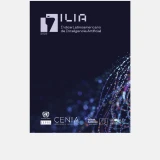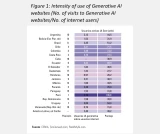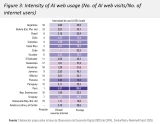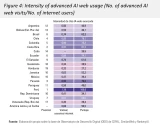Latin America’s AI Adoption in Focus: RankmyAI’s Data in the ILIA 2025 Report
Written by Jesse Weltevreden
The Índice Latinoamericano de Inteligencia Artificial (ILIA) 2025 is the most comprehensive study of AI adoption in Latin America and the Caribbean. RankmyAI contributed data that helped shape indicators on AI web traffic and intensity of use across 19 countries. This article summarizes the main results.

A Landmark Report for the Region
The Índice Latinoamericano de Inteligencia Artificial (ILIA) 2025 is the most comprehensive analysis so far of artificial intelligence in Latin America and the Caribbean. Published by the United Nations Economic Commission for Latin America and the Caribbean (ECLAC) in collaboration with Chile’s National Center for Artificial Intelligence (CENIA), the report evaluates AI ecosystems across 19 countries.
ILIA 2025 examines policy frameworks, levels of adoption and socio-economic effects of AI technologies. Its findings give governments, researchers and companies a benchmark for evidence-based decision making and regional cooperation.
RankmyAI’s Contribution
RankmyAI is cited twelve times in the report. Our global database of AI tools and companies, combined with web traffic analysis, served as a data source for several adoption indicators.
The Digital Development Observatory (DDO) research team at ECLAC carried out the statistical analyses and interpretation. RankmyAI contributed the underlying dataset of AI solutions with significant web presence in Latin America. This enabled the authors to identify and classify more than 260 AI websites most frequently accessed by users across 19 countries. The dataset also made it possible to distinguish between generative AI tools designed for end users and more advanced platforms such as developer tools, APIs and open-source frameworks.
This contribution shows that RankmyAI is not only the world’s largest AI tools directory, but also a trusted provider of data for research on AI ecosystem mapping and analysis.
Results Based on RankmyAI Data
The ILIA 2025 report introduces a new indicator called AI web traffic to measure how internet users in Latin America and the Caribbean adopt AI solutions online. This indicator is based on the number of visits to AI websites, using a sample of the 260 most visited sites across 19 countries. The list of websites was built from public rankings provided by Similarweb and RankmyAI.
To ensure consistency, the authors applied four criteria to determine what qualifies as an AI solution. A website had to explicitly include AI components such as models, algorithms or APIs; its functionality had to rely on AI as a central element, not merely as an auxiliary feature; it had to be accessible to end users; and it had to have been accessed from at least one country in the region, regardless of where the solution originates.
Once identified, the websites were grouped into three categories: generative AI solutions; AI models and APIs; and open-source or developer platforms. For analytical purposes, the last two categories were combined as “advanced AI use.” The AI web traffic indicator is composed of two sub-indicators — the intensity of AI web use and the intensity of advanced AI web use — and together they account for 25% of the overall adoption dimension in the ILIA framework.
Intensity of Use of Generative AI Websites
This sub-indicator measures visits to generative AI websites relative to the size of the internet population in each country. The results show Peru with the maximum score of 100 points, followed by Costa Rica (77.5), Colombia (73.0), Chile (71.5), Panama (70.8), Ecuador (69.9) and Uruguay (64.0) (figure 1). All these countries are well above the regional average of 49.2 points. Brazil scores 51.2 points, placing it just above the mean but below the leading group.

Overall AI Web Traffic
When all AI websites are considered, the results are similar. Peru again ranks first with 100 points, while Costa Rica (79.7), Panama (76.2), Chile (75.5), Colombia (74.4), Ecuador (72.4) and Uruguay (66.4) also perform strongly (figure 2). Brazil (57.8) is above the regional average of 53.6 points, which means eight countries in total surpass the regional benchmark. Peru’s leading position reflects its high performance in both generative and advanced sub-indicators.

Average AI Visits per Internet User
Another perspective is the number of AI visits per internet user, which highlights how frequently people interact with AI websites. Peru again stands out, with six visits per user on average, giving it the maximum score of 100 points (figure 3). Costa Rica (78.2), Colombia (73.5), Chile (72.8), Panama (72.6), Ecuador (70.7) and Uruguay (64.8) all surpass the 60-point threshold. Brazil scores 53.4 points, with three visits per user, which still places it above the regional average of 50.6 points.


Advanced AI Web Use
This sub-indicator focuses on traffic to more technical platforms, such as developer tools, APIs and open-source environments. Peru leads with 1.19 visits per user, equivalent to 100 points (figure 4). Costa Rica (81.2), Panama (79.8), Chile (78.1), Colombia (75.3) and Ecuador (74.1) follow closely. Uruguay (68.0), Brazil (62.3) and El Salvador (61.9) are also above the regional average of 56.5 points, which shows that advanced adoption is starting to take shape in several countries beyond the top performers.
Regional Synthesis
The report also provides a regional overview that puts these results into context and compares Latin America with global trends. It shows that the region accounts for 14% of global AI web visits while representing only 11% of global internet users (figure 5). This means the region is using AI solutions at a higher rate than its global digital weight would suggest.
Adoption, however, is concentrated. Six countries — Brazil, Mexico, Colombia, Peru, Argentina and Chile — together account for 86% of all regional traffic.

A second group of countries, including Ecuador (59 million visits), Costa Rica (20 million), the Dominican Republic (19 million), Venezuela (19 million), Bolivia (18 million) and Guatemala (17 million), show intermediate volumes. A third group — Panama, Uruguay, Paraguay, El Salvador, Honduras and Jamaica — record between six and fifteen million visits, consistent with their smaller market size.

The report also identifies the main drivers of adoption. High mobile internet penetration (70% of the population in 2024) and widespread smartphone use (81%) make access easier. A young and digitally active population adapts quickly to new technologies, and the simple interfaces of generative AI tools lower barriers to entry.
At the same time, the concentration of use in a handful of countries is explained by higher levels of connectivity, entrepreneurial capacity and clearer regulatory frameworks, which reduce barriers to experimentation. The limited use of advanced AI solutions points to bottlenecks in specialized talent, data infrastructure, sophisticated demand for integration, and coordination between academia, industry and government. Without addressing these challenges, the region risks consolidating itself as a consumer of AI solutions, with limited local capacity to develop and adapt them.
Implications
The results show that Latin America’s use of AI is higher than expected given its share of the global internet population. Adoption is strong, especially for generative AI, but advanced usage remains limited. This pattern reflects both opportunities and challenges.
For governments, the priority is to ensure that adoption translates into productive capacity. Investments in skills, infrastructure and innovation support are needed to foster local development of AI solutions. For companies, the data highlights where AI adoption is already established and where markets for AI-enabled services are likely to grow.
Closing Reflection
Being included in ILIA 2025 confirms RankmyAI’s role as a reliable data source for research and policy analysis. Our mission is to provide objective insights into the global AI ecosystem. The fact that our data was used by ECLAC and CENIA in such a significant regional study shows that RankmyAI contributes to evidence-based decision making at an international level.
We will continue to expand our database and improve data quality, so that policy makers, researchers and AI solution developers worldwide can rely on accurate information about the development and adoption of AI.
Disclaimer
This article is based on a translation and summary of the sections of the Índice Latinoamericano de Inteligencia Artificial (ILIA) 2025 where RankmyAI data was used. The analysis and interpretation were carried out by ECLAC and CENIA. RankmyAI provided the underlying data but is not the author of the study. For the complete analysis and all results, please refer to the full report in Spanish.
Reference
Durán, R., Moreno, A., Adasme, S., Rovira, S., Jordán, V. & Poveda, L. (Coords.) (2025). Índice Latinoamericano de Inteligencia Artificial (ILIA) 2025. Documentos de Proyectos (LC/TS.2025/68). Comisión Económica para América Latina y el Caribe (CEPAL) y Centro Nacional de Inteligencia Artificial (CENIA).
Download the full report in Spanish here.
Download an English article of the DDO team about the report here.






